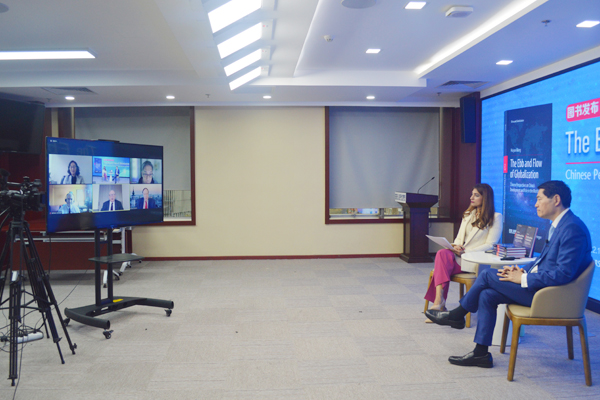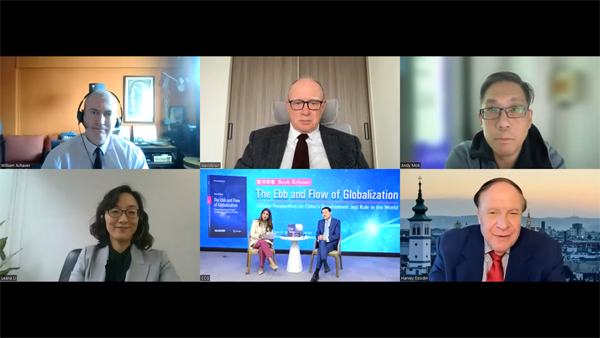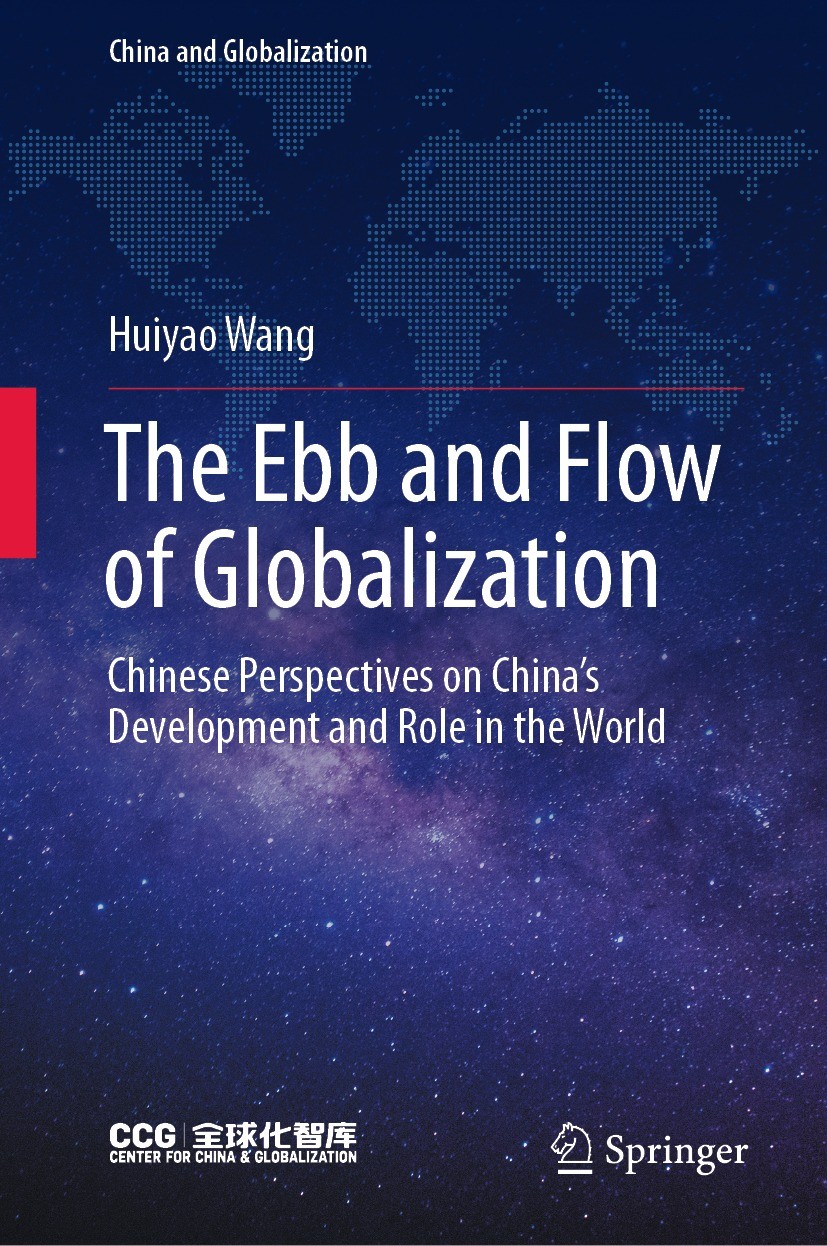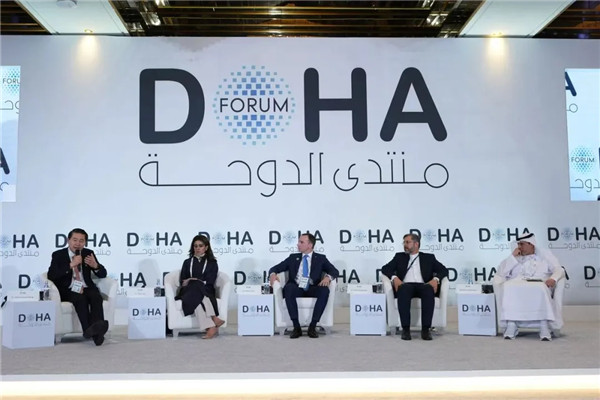CCG launches new book – The Ebb and Flow of Globalization
October 27 , 2022On October 27, Dr. Henry Huiyao Wang’s latest work, The Ebb and Flow of Globalization, published by Springer Nature, was released online.
William Achauer, Editorial Director for Business, Economics and Political Sciences and Law at Springer Nature delivered opening remarks and Dr. Henry Huiyao Wang, Founder and President of the Center for China and Globalization, chaired the official release of the book. Leana Li, Regional Director for Books for China at Springer Nature, David Blair, economist and writer, Andy Mok, Commentator for CGTN and Harvey Dzodin, Senior Consultant of the National Image Communication Research Center of Tsinghua University and freelancer attended the event and discussed the future of globalization and great power relations. The event was hosted by Zoon Ahmed Khan, Research Fellow at CCG.
Globalization is an unstoppable force. Given the high stakes at hand – international stability, continued economic growth, and the future of our planet – it is more important than ever that China gain a deeper understanding of the rest of the world, and that the rest of the world also comes to gain a clearer understanding of China. As the world witnesses dramatic geopolitical changes and rising anti-globalization, it is essential that we discuss the direction globalization is taking and the role China can play.
This book, published in August, features a selection of Dr. Wang’s writings published between 2016 and 2021 by domestic and overseas media and institutions including Beijing Review, Bloomberg, China Daily, CGTN, The Financial Times, Global Times, The Indian Express, Munich Security Conference, South China Morning Post, the Wilson Center, and the World Economic Forum. It is one of the few works in English that looks at China and the development of globalization from the perspective of a Chinese scholar, offering a comprehensive overview of China-related policy issues.
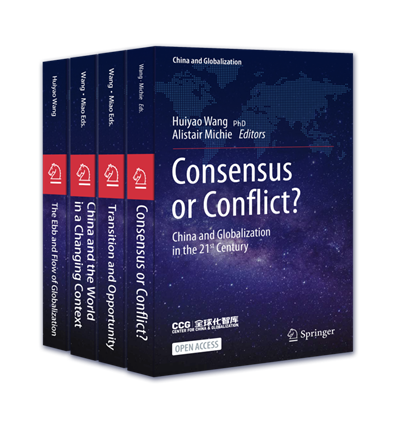
The Ebb and Flow of Globalization is the latest volume in the “China and Globalization” series. Previous volumes of this series include The Asian 21st Century, Transition and Opportunity: Strategies from Business Leaders on Making the Most of China’s Future, and China and the World in a Changing Context: Perspectives from Ambassadors to China. The first four books in the series are open access and all five volumes are currently available on Springer Nature’s website, receiving a warm welcome worldwide with total downloads exceeding 2 million.
This book focuses on globalization and China’s evolving role in the world. By any measure, these five years mark a pivotal period for China and global affairs, which saw major changes in geopolitics, economic cooperation, and global governance in which there both progress and setbacks were seen, which Dr. Wang views as a natural phenomenon of “ebb and flow” in globalization.
The five years that this book covers is book-ended by two seismic events: the election of US President Donald Trump in 2016 and the COVID-19 pandemic of 2020-21. These, in addition to the war in Ukraine, have resulted in global ramifications that will affect the world for many years to come.
This period also witnessed China’s landmark 19th Party Congress, which marked a new era for the nation and its integration with the world; twists and turns in the China-US relationship, which marked a new phase of great power competition and brought uncertainty to the international system; new developments in regional cooperation, such as the signing of the Regional Comprehensive Economic Partnership (RCEP), the world’s largest FTA; and the continuous development and disruption resulting from new technologies that are changing the way we live, work, and interact with each other. It has truly been a period of ups and downs for globalization, with a host of new trends, challenges, and complexities for those of us in the think tank community to grapple with, research, and write about.
The essays in the book center on three interconnected themes – China’s remarkable development under its policy of Reform and Opening-up, China’s deepening integration into the global economy and rise in an increasingly multipolar world, and the quest to reinvigorate global governance and multilateralism to address the pressing global challenges of the 21st century.
The book is divided into three parts. Part I, Vectors of China’s Globalization, focuses on domestic developments that have shaped different aspects of China’s integration into the rest of the world. These include China’s evolving role in trade and investment, the improvement of laws and the overall business environment, the effectiveness of China’s democracy, the rise of Chinese multinational corporations, educational, cultural and professional ties, as well as the need to make China a global talent hub.
Part II China’s Rise in a Multipolar World takes a step back to look at China’s external relations in a changing world. It highlights and adaptions of China’s diplomacy in a changing context, how to create a new Chinese narrative in the global arena, the attempt to achieve a truce between US and China in today’s tech Cold War and manage conflict. It also examines the dawn of the Asian Century, China’s role in a more integrated Asia, Asian countries’ economic dependence on on counting on China as well as the US focus on security, China-EU relations in a changing era looking back at and beyond the Merkel era.
Part III Reinvigorating Multilateralism looks at the strains on our current system of global governance and identifies key areas for reform and innovation that will allow us to cooperate effectively and address the pressing global challenges of the twenty-first century. This part suggests China lead the way to save the ailing WTO and revive multilateralism, while also take advantage of the opportunity to join the CPTPP to promote a more integrated trading order in Asia. This part argues that RCEP’s synergy with China’s economic strategy bodes well for Asia-Pacific, and Build Back Better could work well with the BRI to close the infrastructure gap. Dr. Wang also advocates that the AIIB can be a key support structure for the BRI and it can expand its remit to build a greener, more inclusive post-pandemic world.
These insights are useful for academics, policymakers, students, and anyone trying to deepen their understanding of China’s development and role in making globalization work for our multipolar world.
Dr. Henry Huiyao Wang is Founder and President of Center for China and Globalization (CCG), a think tank ranked among top 100 think tanks in the world. He is also Dean of the Institute of Development Studies of Southwestern University of Finance and Economics of China, Vice Chairman of China Association for International Cooperation, and Director of Chinese People’s Institute of Foreign Affairs. He is currently a Steering Committee Member of the Paris Peace Forum and an Advisory Board Member of the Duke Kunshan University. He pursued his Ph.D. studies at University of Western Ontario and University of Manchester. He was Senior Fellow at Harvard Kennedy School and Visiting Fellow of Brookings Institute, and an adjunct professor at Peking University. In addition to its top ranking as a world think tank, CCG is also the only non-governmental Chinese think tank that has been granted special consultative status by the United Nations.
Content
Introduction: The Journey of Reform and Opening-Up
PART 1 VECTORS OF CHINA’S GLOBALIZATION
Chapter 1 China’s evolving role in trade and investment
1.Foreign Investment Law will lift opening-up to a new level
2.Rising FDI reflects China’s openness and improved business environment
3.China rises from “Special Economic Zones” to anchor of the global economy
4.CIIE marks a new economic era
5.A trinity of growth drivers for the post-pandemic era
6.How creating a better business environment can boost foreign investment in China
7.From moderate prosperity to modern society
8.’Consultative democracy’ a key part of China’s approach to democracy
9.Effectiveness of Chinese democracy: meritocracy, market democracy and technocracy
Chapter 2 The rise of Chinese multinationals
10.Partnering for success
11.Smarten up and take the lead
Chapter 3 Education, talent and cultural ties
12.Gaokao resumption was the start of a new era
13.Chinese universities need to attract more foreign students, but not by treating them differently
14.How to encourage the flow of Hong Kong’s youth, talent and innovation across the Greater Bay Area
15.China is running the world’s largest tourism deficit. How can it plug the gap?
16.Building a global talent hub for China’s future development
PART 2 CHINA’S RISE IN A MULTIPOLAR WORLD
Chapter 4 Reflections on the changing international order
17.We should focus on real threats, not illusory ones
18.Beyond “Westlessness”: Building a more inclusive order for the new decade
19.How COVID-19 will reinforce trends shaping the international order
Chapter 5 Chinese diplomacy in a changing world
20.Challenging times, creative efforts – Highlights of Chinese diplomacy in 2018
21.Building a shared future for all – Highlights of Chinese diplomacy in 2019
22.Highlights of China’s diplomacy for the post-pandemic world
23.Creating a new Chinese narrative in the global arena
Chapter 6 China-US relations in flux
24.China-US relations at 40: Different dreams, shared future
25.Instead of US-China decoupling, the new decade should bring acceptance of different development models
26.US and China should seek a truce in tech Cold War
27.How Biden could improve US-China relations
28.Sino-US competition need not entail conflict
29.“Climate Superpowers?” Why the Cold War is the wrong analogy for our heating planet
Chapter 7 China’s role in a rising, more integrated Asia
30.Dawn of the Asian Century
31.New chapter in China-Japan relations can drive Asian integration
32.Can China and India overcome their Himalayan differences to benefit Asia?
33.India, China must look to the future
34.From the Syrian civil war to Yemen to energy, China has a larger role to play in the Middle East
35.The two sides of Asia: China’s economic priorities vs the US’ focus on security
Chapter 8 China-EU relations
36.Transcending “us versus them”: China-EU relations in a changing era
37.China and EU can boost cooperation on digital economy
38.China, a land of opportunity for EU firms willing to adapt
39.EU deal is a milestone for China’s globalization that can help build a new world economic order
40.Germany as a mediating power
41.Looking back at and beyond the Merkel era
PART 3 REINVIGORATING MULTILATERALISM
Chapter 9 Global challenges and joint solutions
42.China can be the unifier the world needs to tackle environmental crisis
43.No country is an island in the climate crisis
44.Embracing the green spirit
45.Cooperation is the core of humanity’s immune system
46.COVID-19 is a call for a resilient globalization
Chapter 10 Finding a way forward for free trade
47.From confrontation to cooperation: How to manage the next era of globalization
48.Why China should lead the mission to save the ailing WTO and revive multilateralism
49.The WTO can be an institutional catalyst for post-pandemic recovery
50.How China’s economic heft can reshape the WTO and global trade for the better
51.A transpacific window of opportunity
52.China should seize the day and join the CPTPP to promote a more integrated trading order in Asia
53.China should join the trade deal the US abandoned
54.RCEP’s synergy with China’s economic strategy bodes well for Asia-Pacific
Chapter 11 Evolution of the Belt and Road
55.Spurring global cooperation and development through the Belt and Road
56.AIIB can be a key benchmark for the BRI
57.Redefining the BRI as a global growth project
58.How the China-led AIIB can expand its remit to build a greener, more inclusive post-pandemic world
59.Build back better vs Belt and Road: to improve infrastructure, competition must yield to cooperation
Index
